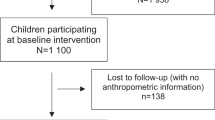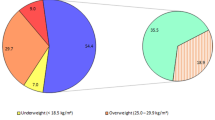Abstract
OBJECTIVE: To study the body composition of Bahraini school children.
DESIGN: Cross-sectional national school survey.
SUBJECTS: School children aged 6–18 y. The sample comprised 818 boys and 775 girls.
MEASUREMENTS: Weight, height, arm circumference and skinfold thicknesses were measured. Sum of skinfold thickness, body mass index (BMI), mid arm circumference, percentage body fat, fat weight and lean body weight were then calculated to determine body composition.
RESULTS: A significant difference in the sum of skinfold thickness was observed between boys and girls. The girls have almost 50% extra skinfold thickness than boys at all ages. Similar trends were found in BMI, except at ages 9 and 18 y. The percentage of body fat was higher in girls than boys. The mean BMI for Bahraini girls aged 13 y and above exceeds that of their American counterparts, indicating a trend towards fat accumulation in the Bahraini girls.
CONCLUSION: The data obtained are useful for monitoring obesity in school children in Bahrain as well as being usable as reference data for similar countries in the region. The high proportion of body fat among Bahraini school children, especially girls, urges an intervention program to prevent and control obesity in this age group.
This is a preview of subscription content, access via your institution
Access options
Subscribe to this journal
Receive 12 print issues and online access
$259.00 per year
only $21.58 per issue
Buy this article
- Purchase on Springer Link
- Instant access to full article PDF
Prices may be subject to local taxes which are calculated during checkout
Similar content being viewed by others
References
Musaiger AO, Miladi S . Diet-related non-communicable diseases in the Arab countries of the Gulf FAO/RNE: Cairo, Egypt 1996.
WHO . Diet, nutrition and the prevention of chronic diseases Technical Report Series no. 797. WHO: Geneva 1990.
Serdula MK, Ivery D, Coates RJ, Freedman DS, Williamson DF and Byers T . Do obese children become obese adults? A review of the literature Prev Med 1993 22: 167–177.
Eid N, Al-Hooti S, Bourisly N, Khalafawi M . Nutritional anthropometric of school children in Kuwait Nutr Report Int 1986 33: 253–260.
Musaiger AO, Gregory WB, Haas JD . Growth patterns of school children in Bahrain Ann Hum Biol 1989 16: 155–167.
Al-Shoshan A . Growth patterns of selected primary school children in Riyadh, Saudi Arabia Saudi Med J 1993 14: 53–58.
Musaiger AO, Gregory WB . Height, weight, arm circumference and skinfold thickness of Bahraini children aged 6–18 y Arab Nutrition Society: Al-Ain, United Arab Emirates 1997.
Jelliffe DB . Assessment of the nutritional status of the community World Health Organization: Geneva 1966.
Gibson RS . Principles of nutritional assessment Oxford University Press: New York 1990.
McArdle WD, Katch FI, Katch VL . Exercise physiology Lea & Febiger: Philadelphia, PA 1986.
Musaiger AO, Matter AM, El-Ekri SA, Mahdi AE . Obesity among secondary school students in Bahrain Nutr Health 1993 9: 25–32.
Central Statistics Organization (CSO) . Statistical Abstracts 1981–1997 Bahrain 1998.
Musaiger AO . Nutritional status and dietary habits of adolescent girls in Oman Ecol Food Nutr 1994 31: 227–237.
Abahussain NA, Musaiger AO, Nicholls PJ, Stevens R . Nutritional status of adolescent girls in the Eastern Province of Saudi Arabia Nutr Health 1999 13: 171–177.
Must A, Dallal GE, Dietz WH . Reference data for obesity: 85th and 95th percentiles of body mass index (wt/ht2) and triceps skinfold thickness Am J Clin Nutr 1991 53: 839–849.
Moussa MAA, Skaik MB, Selwanes SB, Yaghy OY, Bin-Othman SA . Contribution of body fat and fat patterns to blood level in school children Eur J Clin Nutr 1994 48: 587–590.
Frisancho AR . New norms of upper limb fat and muscle areas for assessment of nutritional status Am J Clin Nutr 1981 34: 2540–2545.
Blair D, Gregory WB . The nutrition status of Bahraini school girls aged 7–18 y Bahrain Sport Institute: Bahrain 1985.
Zaghloul NE, El-Sherbini AF, Al-Shayeb FA . Dietary factors and physical activity of obese and non-obese adolescents Bull High Inst Publ Hlth 1984 14: 31–49.
Author information
Authors and Affiliations
Rights and permissions
About this article
Cite this article
Musaiger, A., Gregory, W. Profile of body composition of school children (6–18 y) in Bahrain. Int J Obes 24, 1093–1096 (2000). https://doi.org/10.1038/sj.ijo.0801371
Received:
Revised:
Accepted:
Published:
Issue Date:
DOI: https://doi.org/10.1038/sj.ijo.0801371
Keywords
This article is cited by
-
A Comparative Study on Fat Pattern between Tribal and Non-tribal Girls of Tripura, North-East India
The Indian Journal of Pediatrics (2019)
-
Energy and macronutrient intake and dietary pattern among school children in Bahrain: a cross-sectional study
Nutrition Journal (2011)
-
Fat and fat-free mass in Nepalese children: an assessment of nutritional status
European Journal of Pediatrics (2009)
-
Anthropometric Characteristics of Pakistani School Children Living in Bahrain
Journal of Immigrant and Minority Health (2009)
-
Association between stunting and overweight among 10–15-y-old children in the North West Province of South Africa: the THUSA BANA Study
International Journal of Obesity (2004)



